On the tracks of Chinese infrastructure projects in Budapest
Author: Giles Mohan
Major infrastructure projects present a paradox. At one level the finished project is designed to do something to make life ‘better’ whether that be travel, communication or energy supply. It’s about providing an efficient, clean, and seamless service that can almost be taken for granted. We switch on a kettle and expect the water that came from the taps to be heated quickly to make our cup of tea. But on another level the process of getting to that point is extremely complex, enrols lots of different actors, and is messy in the sense that systems need to be planned, built, and maintained.
In trying to research the assembling of a major infrastructure project we must do many things which require inter-disciplinarity and multiple methods. Some approaches take an economistic line – such as cost-benefit analysis – or an engineering life cycle approach. These are useful but can underplay the complexity of the actors, processes, and effects. In our project we are combining a critical approach to assemblages with a technique called process tracing to analyse the ways in which projects come together and how key causal moments shift these projects along, though not always – indeed very rarely – fully in the intended way.
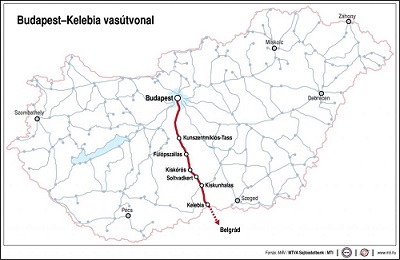
Recently we were in Budapest to look at several Chinese infrastructure projects. One of them is a railway project, 85% financed by a Chinese bank. The Belgrade-Budapest Railway Upgrade links two European capitals and is made up of two related projects – one on the Hungarian side and one on the Serbian side. We left central Budapest on a bright yellow tram and headed south, tracking along the eastern bank of the Danube across from the grand palaces and monuments on the Buda side of the river. At Közvágóhíd we changed to a green and white suburban HÉV train. The grandiose buildings of central Budapest gave way to lower rise houses, interspersed with shops and other businesses. We alighted at Soroksár, Hősök tere which is a quiet neighbourhood with walled gardens. After a 10-minute walk and we came to a deserted railway station, the intended terminal point of the Belgrade-Budapest Railway in Hungary.
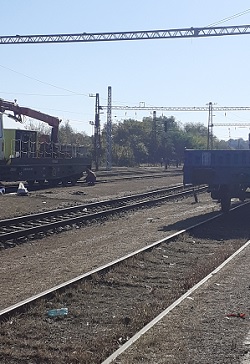 The station was small as befits a suburban station. Memorial plaques to the Holocaust and the period after the Second World War spoke of a troubled history. The railway line was closed but made up of four tracks and overhead cables held up by metal poles, though the current line relies on just one of these tracks. The sign outside the station building announced the closure and indicated that a replacement bus service would take passengers to the ends of the closed section, which would entail quite a hassle for months to come.
The station was small as befits a suburban station. Memorial plaques to the Holocaust and the period after the Second World War spoke of a troubled history. The railway line was closed but made up of four tracks and overhead cables held up by metal poles, though the current line relies on just one of these tracks. The sign outside the station building announced the closure and indicated that a replacement bus service would take passengers to the ends of the closed section, which would entail quite a hassle for months to come.
A small team of Magyar Államvasutak (MÁV) engineers were on site. White vans with MÁV logos were parked on the gravel. Across the tracks a man knelt with a circular saw, cutting through the struts of one of the poles holding up the cables, sparks flying. The rest of the team had a rope attached to the top of the pole and as the man with the saw completed his job the others pulled the pole which fell to the ground smashing the ceramic insulators. The team moved on to the next pole. These mundane acts were about clearing the old infrastructure to make way for the new technologies that the Chinese are funding. Witnessing the destruction of one rusting pole was an entry point into this diffuse and expansive assemblage whereby we seek to track (literally in this case!) the actors and actions involved in bringing this infrastructure into being.
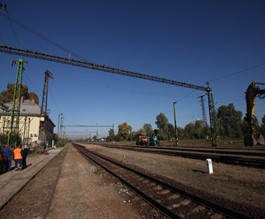 The MÁV team were friendly but bemused by a team of British, German, Italian, and Chinese social scientists taking photos of a deserted, dusty, and rusty railway. An infrastructure assemblage is made up of human and non-human actors and it is not enough to simply fixate on the power of the powerful, like the financiers which back the project or the governments who commission it. The assemblage must be entered from multiple vantage points and as researchers we iteratively build up a more and more complex picture of who is involved, how and with what effects. And these effects are also conditioned by the materiality of the (literal) stuff that is being brought to bear – in our case the old tracks, cables, stations, IT networks etc. – which will supposedly transform a decayed and inefficient railway into a key part of a transport corridor linking the Port of Piraeus in Greece – also run by a large Chinese state-owned enterprise – to markets and production centres in Central and Eastern Europe and potentially onwards to more profitable markets in Western Europe. The vision is that one day the travel time of containers from China to Western Europe could be cut by 7-10 days compared with using ships to traverse the Mediterranean, go around the Iberian Peninsula and then through the English Channel to the ports of Rotterdam or Hamburg. We’ll see.
The MÁV team were friendly but bemused by a team of British, German, Italian, and Chinese social scientists taking photos of a deserted, dusty, and rusty railway. An infrastructure assemblage is made up of human and non-human actors and it is not enough to simply fixate on the power of the powerful, like the financiers which back the project or the governments who commission it. The assemblage must be entered from multiple vantage points and as researchers we iteratively build up a more and more complex picture of who is involved, how and with what effects. And these effects are also conditioned by the materiality of the (literal) stuff that is being brought to bear – in our case the old tracks, cables, stations, IT networks etc. – which will supposedly transform a decayed and inefficient railway into a key part of a transport corridor linking the Port of Piraeus in Greece – also run by a large Chinese state-owned enterprise – to markets and production centres in Central and Eastern Europe and potentially onwards to more profitable markets in Western Europe. The vision is that one day the travel time of containers from China to Western Europe could be cut by 7-10 days compared with using ships to traverse the Mediterranean, go around the Iberian Peninsula and then through the English Channel to the ports of Rotterdam or Hamburg. We’ll see.
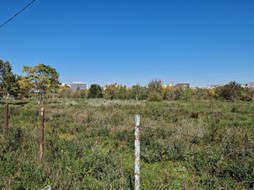 We headed back towards central Budapest, got off the HÉV suburban train at Közvágóhíd and wandered down a busy dual carriageway towards a half-built athletics stadium in a former industrial zone. Litter had blown into the bushes and, again, the picture was one of dusty construction with lorries rumbling past loaded with concrete ready to pour. To the left of the dual carriageway was a rough piece of land, with small willow trees and criss-crossed by informal paths.
We headed back towards central Budapest, got off the HÉV suburban train at Közvágóhíd and wandered down a busy dual carriageway towards a half-built athletics stadium in a former industrial zone. Litter had blown into the bushes and, again, the picture was one of dusty construction with lorries rumbling past loaded with concrete ready to pour. To the left of the dual carriageway was a rough piece of land, with small willow trees and criss-crossed by informal paths.
This is the proposed site of the Fudan University campus, a controversial collaboration between a major Chinese university and the Hungarian government. The plot has a land value of €2.3m. The project is to be financed via a €1.5bn loan from the China Development Bank with construction undertaken by China State Construction Engineering Corporation (CSCEC), a company blacklisted by the US due to suspicions over espionage. Principally, CSCEC will use materials and labour sourced from China, though percentages of each remain unknown. More shiny new infrastructure is promised to transform this unprepossessing landscape though as yet the deal has not been agreed and no ground has been broken.
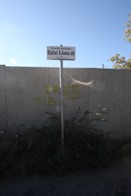 But not everyone is happy with the proposal. The Budapest City government does not want the branch campus. The central Hungarian Government under Fidesz rule will underwrite the cost of the buildings and the Budapest government is anti-Fidesz which partly explains their antipathy to the campus. It is hard to resist the increasingly authoritarian government in Hungary, but the City has protested by renaming the streets around the proposed campus site – Road of the Uighur Martyrs, Dalai Lama Street, Free Hong Kong Street.
But not everyone is happy with the proposal. The Budapest City government does not want the branch campus. The central Hungarian Government under Fidesz rule will underwrite the cost of the buildings and the Budapest government is anti-Fidesz which partly explains their antipathy to the campus. It is hard to resist the increasingly authoritarian government in Hungary, but the City has protested by renaming the streets around the proposed campus site – Road of the Uighur Martyrs, Dalai Lama Street, Free Hong Kong Street.
These small signs are symbols of a resistance which may prove fruitless. But they are a way into understanding a complex and politically charged process of infrastructure construction that links these rather dismal sites to a world of geopolitics and struggles for accountability.
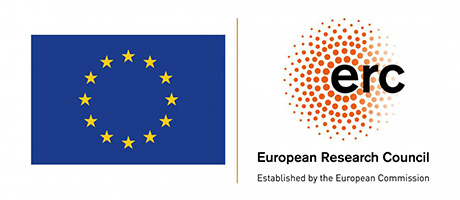
Get in touch
Contact the team at REDEFINE@open.ac.uk
or write to us at:
REDEFINE PROJECT
Faculty of Arts and Social Sciences
The Open University
Milton Keynes
MK7 6AA
UK

